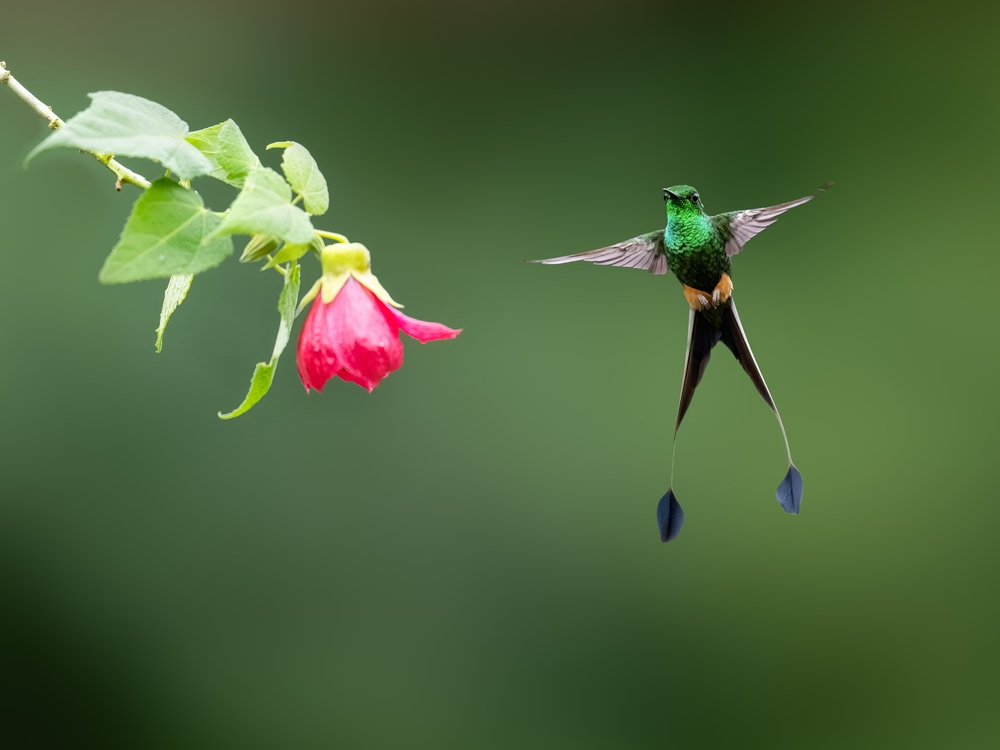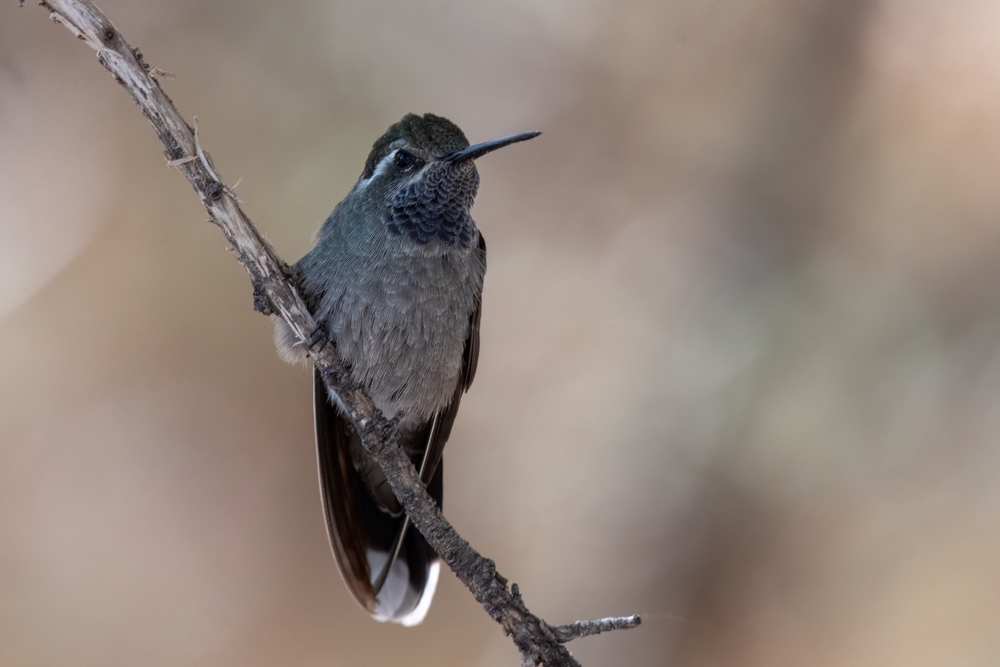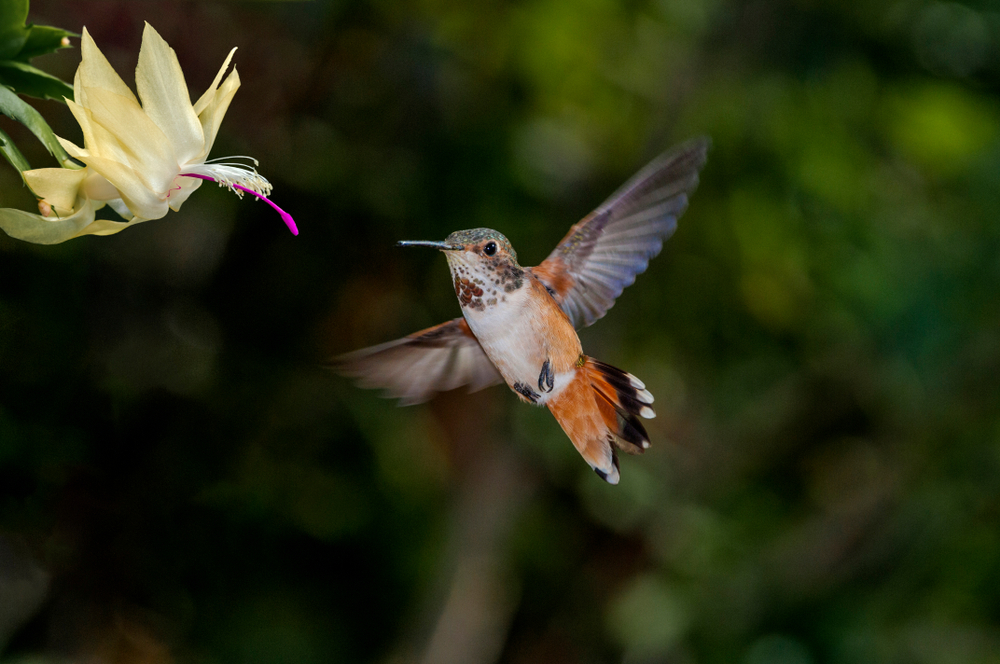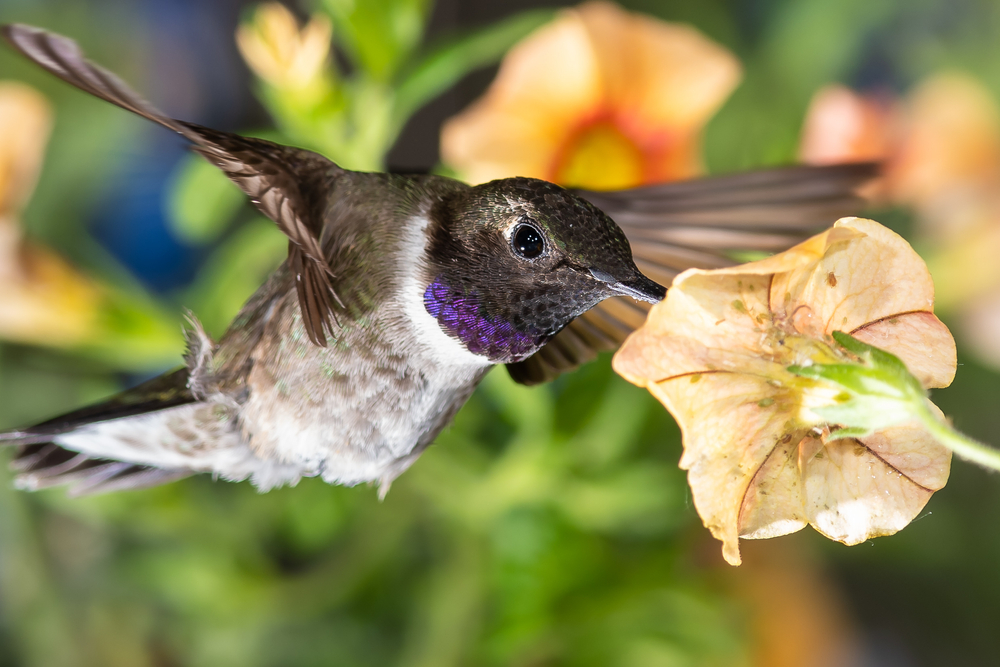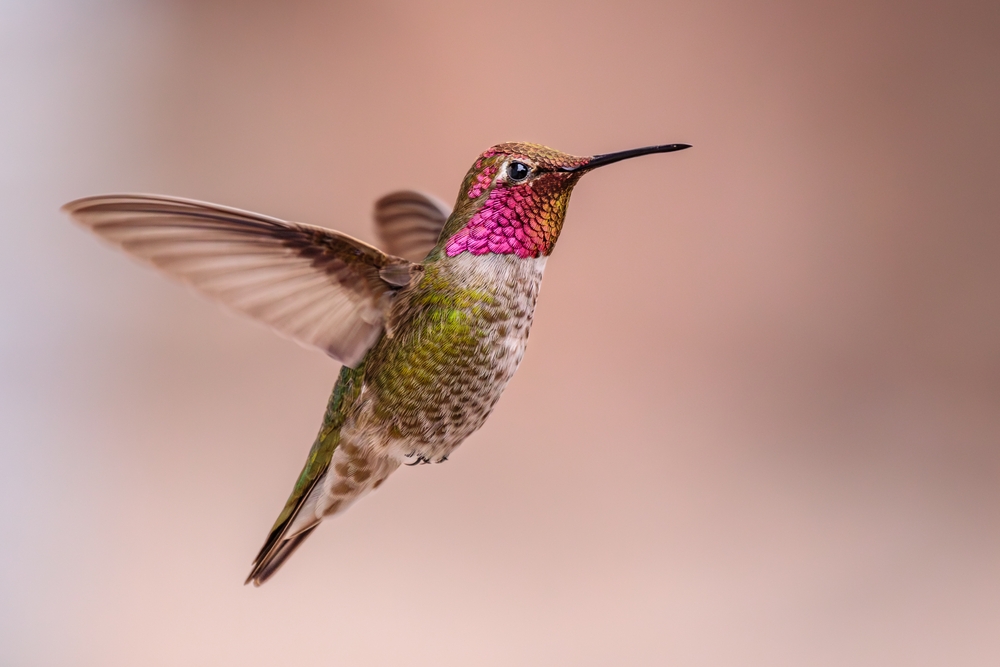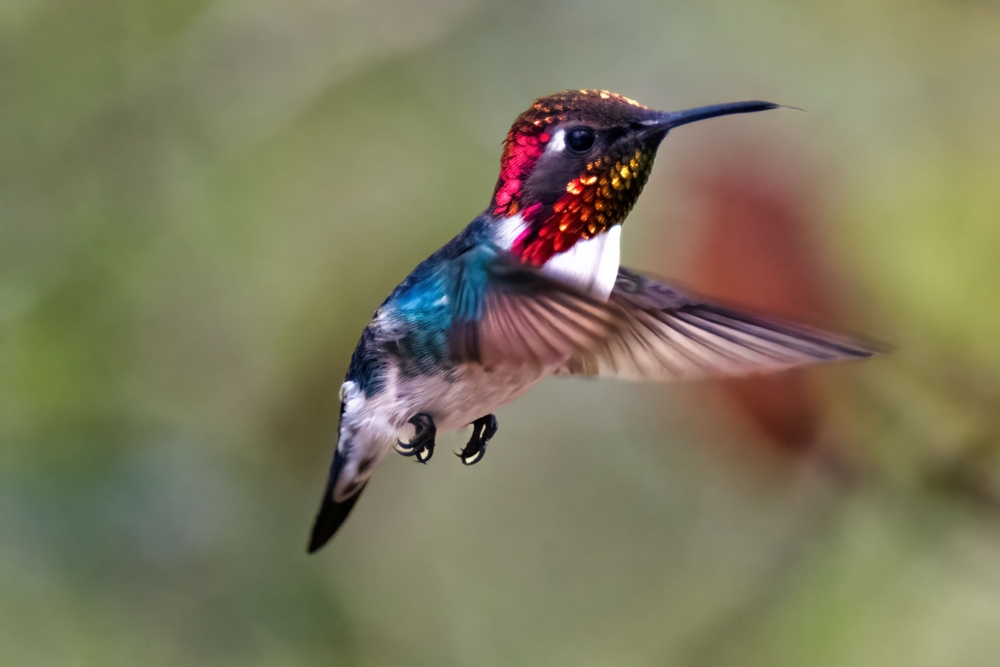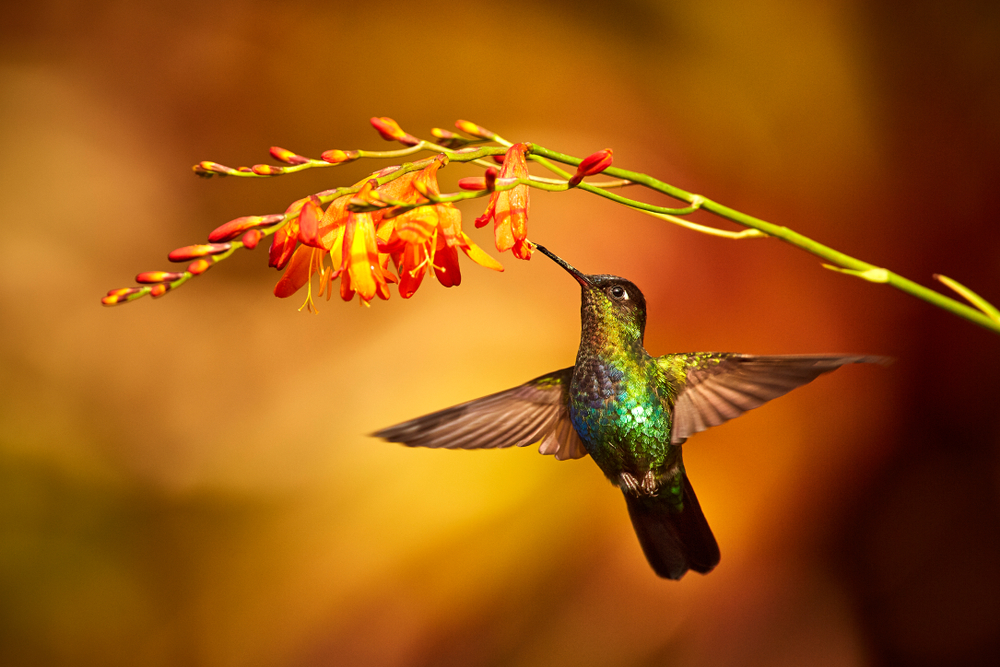The Booted Racket-tail (Ocreatus underwoodii) is closely related to other South American hummingbirds in the same genus, particularly the Peruvian Racket-tail (Ocreatus peruanus) and White-booted Racket-tail (Ocreatus addae), which share the trademark “rackets” and fluffy leg tufts.
About
The Booted Racket-tail (Ocreatus underwoodii) is a small and enchanting hummingbird of the family Trochilidae, found in the Andean regions of South America. Ranging from Venezuela and Colombia south through Ecuador, Peru, and Bolivia, it inhabits humid montane forests, forest edges, and cloud forests, typically at elevations between 1,500 and 3,000 meters (4,900–9,800 ft). This species is especially admired for its ornate tail feathers and fluffy leg tufts, which set it apart as one of the most elegant hummingbirds of the Andes.
Measuring only 10–15 cm (4–6 in) in length, much of its size comes from its extraordinary tail. Males sport elongated outer tail feathers tipped with rackets—oval discs that dangle and swing as they fly. In addition, they possess distinctive puffy white feather tufts around their legs, resembling “boots,” which give the bird its name. Females are smaller, lack the racket-shaped feathers, and are generally more subtly marked, with green upperparts and whitish underparts speckled with green.
The Booted Racket-tail feeds primarily on nectar from a wide variety of tubular flowers, often hovering delicately as it forages. Its diet is supplemented by small insects and spiders, which provide essential protein. Males are territorial and use their tails in courtship displays, performing fluttering flights to attract females while their racket-shaped feathers swing dramatically.
Breeding habits vary across its range, but females alone build the tiny cup-shaped nests from moss, lichen, and spider silk, carefully camouflaged among branches. Two tiny white eggs are typically laid, and the mother incubates and raises the chicks on her own.
While not currently threatened, the Booted Racket-tail depends on healthy montane and cloud forest ecosystems. Deforestation and habitat fragmentation in the Andes pose risks, making conservation of these habitats critical for its survival.
Physical Characteristics
Plumage:
The Booted Racket-tail (Ocreatus underwoodii) is a small, dazzling hummingbird famous for its unique tail.
-
Male: Metallic green body with a glittering throat, white fluffy “boots” of feathers around the legs, and a long tail ending in two distinctive racket-shaped outer feathers.
-
Female: Lacks the racket-shaped tail and white boots. She has green upperparts, whitish underparts with dark spotting, and a shorter, more typical hummingbird tail.
Head:
The head is iridescent green with a straight, black bill adapted for sipping nectar. The throat shimmers metallic green in males, while females are paler and spotted.
Body:
Small and compact, with a striking contrast between the sleek green plumage and the fluffy white leg tufts that look like feathered boots—hence the name.
Size:
-
Length: Male 5.1–6.3 in (13–16 cm) including the tail; females smaller, about 3 in (7.5 cm).
-
Wingspan: About 3.5–4.0 in (9–10 cm).
-
Weight: 0.1–0.2 oz (2.5–5 g).
Feet & Tail:
Feet are tiny, used mostly for perching. The male’s tail is long with wire-like shafts ending in rounded disks (“rackets”), while females have shorter, more conventional tails.
Flight Style:
Males are highly acrobatic, performing swinging, pendulum-like flights to display their rackets to females during courtship. Wingbeats are rapid (about 60–70 per second), allowing precise hovering and darting flight.
The Booted Racket-tail’s combination of fluffy white leg tufts and spectacular racket-shaped tail feathers in malesmakes it one of the most ornamental and easily recognized hummingbirds of the Andes.
Reproduction
Breeding Season:
The Booted Racket-tail breeds during the wet season in the Andes when flowers are most abundant. The timing varies with elevation and region but usually falls between February and June.
Courtship:
-
Males display by performing pendulum-like flights, swinging back and forth in front of females while showing off their long racket-shaped tail feathers.
-
They also perch conspicuously and flare their tails to highlight the ornaments.
-
As in most hummingbirds, males do not take part in nesting or chick-rearing after mating.
Nesting:
-
The female alone builds the nest, usually on a slender tree branch, fern, or low shrub.
-
Nests are tiny, about the size of a walnut, made of plant fibers, moss, and spider silk.
-
Camouflage is provided with lichens, bark, or leaf fragments.
Eggs:
-
A typical clutch contains 2 small white eggs, each about the size of a pea (0.5 in / 1.3 cm).
Incubation:
-
Lasts 15 to 16 days.
-
Only the female incubates the eggs.
Chick Development:
-
Hatchlings are altricial, blind, and featherless.
-
The female feeds them regurgitated nectar and tiny insects for protein.
-
Fledging occurs at about 20 to 23 days, though young may continue to receive food from the mother for another week.
Maturity:
-
Juveniles quickly develop foraging skills, imitating adults’ feeding behavior.
-
Sexual maturity is reached at about 1 year of age.
The Booted Racket-tail’s reproduction is notable for its male’s ornamental display flights and the female’s delicate nest construction, perfectly suited for survival in the dense Andean forests.
Lifespan
In the Wild:
Booted Racket-tails generally live 4 to 6 years in their native Andean habitats. Like most hummingbirds, their first year is the most dangerous due to predation and the high energy demands of survival.
In Captivity:
Although rarely kept, individuals in rehabilitation or conservation settings may live a little longer, up to 7 or 8 years, with steady food and protection from predators.
Record Lifespan:
The longest recorded wild Booted Racket-tail, tracked through banding data, lived about 6 years and 4 months.
Threats to Longevity:
-
Predation: Vulnerable to larger birds, snakes, spiders, and mammals.
-
Habitat Loss: Restricted to cloud forests of the Andes, they face threats from deforestation and agricultural expansion.
-
Competition: Other hummingbirds may dominate feeding territories, especially larger, more aggressive species.
-
Climate Change: Alters flowering cycles, potentially disrupting nectar availability.
Despite these pressures, the Booted Racket-tail has evolved to thrive in highland forests, with its agility, specialized feeding, and small size helping it survive several years in the wild.
Eating Habits
Diet:
The Booted Racket-tail feeds mainly on:
-
Nectar: Its primary food, taken from tubular flowers such as fuchsias, bromeliads, and other Andean forest blossoms.
-
Insects & Spiders: Tiny flies, gnats, ants, and spiders provide protein, especially important during chick-rearing.
Foraging Behavior:
-
Uses its slender, slightly decurved bill and extendable tongue to extract nectar while hovering or perching.
-
Frequently feeds at flowering shrubs in forest understory and clearings, favoring plants with high nectar output.
-
Captures insects midair (hawking) or gleans them from leaves, bark, or spider webs.
-
Males are highly territorial, defending patches of flowers from rivals and other hummingbirds, while females forage more widely during nesting.
Feeding Adaptations:
-
Rapid wingbeats (60–70 per second) allow precise hovering in front of flowers.
-
Long tongue with brushy tips adapted for nectar lapping (up to 13 licks per second).
-
Enters nightly torpor to conserve energy, lowering its metabolism drastically until dawn.
Role in Ecosystem:
As a pollinator, the Booted Racket-tail is crucial for many Andean plants, transferring pollen between flowers. By also consuming insects, it helps balance small insect populations in its habitat.
The Booted Racket-tail’s specialized nectar feeding, insect hunting, and aggressive territorial defense make it both a vital pollinator and a competitive presence in Andean hummingbird communities.
Uniqueness
Feathered “Boots”:
This hummingbird is named for the fluffy white leg tufts, or “boots,” that look like tiny feathered pantaloons. These ornaments are unique among hummingbirds and highly distinctive in males.
Racket-shaped Tail Feathers:
Males have elongated outer tail feathers with bare shafts ending in oval discs (“rackets”), giving the bird one of the most unusual tail shapes in the hummingbird family. Females lack these ornaments, showing sexual dimorphism.
Courtship Displays:
Males perform pendulum-like display flights, swinging back and forth while flashing their racket tails to impress females. This ritual highlights their ornaments rather than relying solely on throat iridescence, as many hummingbirds do.
Miniaturized Beauty:
Despite being only 3–4 in (7.5–10 cm) long (excluding the male’s tail extensions), this species is one of the most ornamental hummingbirds of the Andes, often compared to flying jewels for its glittering green body and dramatic tail.
Andean Specialist:
It inhabits cloud forests and montane slopes from Venezuela to Bolivia, restricted to humid, high-altitude environments where it pollinates native plants.
The Booted Racket-tail’s combination of ornamental leg tufts, racket-shaped tail feathers, and acrobatic courtship flights makes it one of the most unique and spectacular hummingbirds in South America.
Be the First to Share Photos of This Species.
FAQ’s
1. What is the closest species to the Booted Racket-tail?
2. How does the Booted Racket-tail compare to other hummingbirds?
Unlike most hummingbirds that rely mainly on iridescent throat patches for display, the Booted Racket-tail uses ornamental leg tufts and racket-shaped tail feathers in its courtship dances. This makes it one of the most visually ornamental species in the Andes.
3. What national parks provide the best opportunities to see a Booted Racket-tail?
They are best seen in Andean cloud forests. Excellent locations include Podocarpus National Park (Ecuador), Sangay National Park (Ecuador), and Manu National Park (Peru), where high-elevation flowering forests support thriving populations.



































































